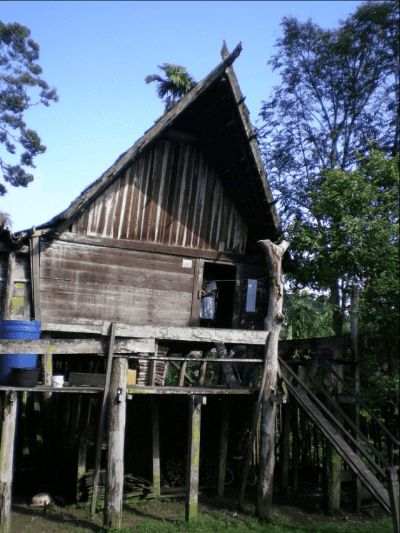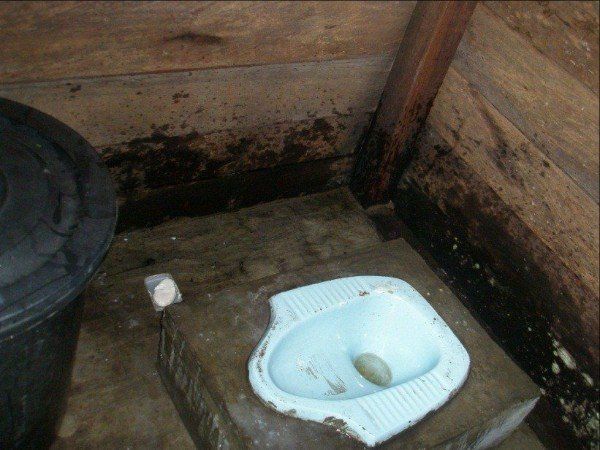Breaking Bread with Headhunters
We were traveling by speedboat for 5 hours upriver to spend a couple of days in Bakonsu, one of hundreds of Dayak villages along the rivers on the island of Kalimantan. Until the 1950’s, Dayaks were relatively unknown to and untouched by Western man. In fact, until that time, they practiced headhunting, usually as part of a war with neighboring villages (as far as I know, they were never cannibals though). Since that time, Dayaks are slowly assimilating Western culture. Today, they pretty much wear Western garb, and they have stopped headhunting, but most of the rest of their lifestyle is relatively unaffected by the West.
Five hours earlier . . .
They had planned to put the three of us, along with a pilot and two guides/translators into a single 15’ speedboat for a five hour high-speed ride up the Arut and Lamandau Rivers of Kalimantan from Kumai to Bakonsu. When the guides saw how large our son, Mike, and I were (I was 6’2” tall and 220 lbs; Mike was quite a bit larger in all dimensions), he quickly called for a second speedboat. I thought they had exaggerated the length of the trip, but no, we traveled at full throttle up those rivers for over five hours. My arthritic back was in significant pain as the boat crashed repeatedly on the water surface disturbed from the wakes of other passing boats. Within an hour, my back ceased to hurt; I had found a way to sit so that the back flexed with the thump-thump-thump. Amazingly, my usually painful back actually was “fixed” by the boat ride . . . at least for a few days. Every few miles, we would pass a small village of around 5-6 rickety homes. Every village looked the same to me. A row of houses along the river, every house had a small dock and outhouse sitting on the dock, as shown below.

The outhouses simply offered some privacy; inside was just a hole open to the river beneath. In many of the villages, children played in the river right next to the outhouses. I do not know where the villagers obtained their drinking water, but it could be either rain (I hope so) or river water. In any case, the river was wide and rapid, and the villages quite well separated, so I did not get the overall impression of excessively unsanitary conditions. I didn’t even realize what was happening until I saw somebody exiting an outhouse just as children were swimming a few feet away.
Soon after our arrival in Bakonsu, the village men started summoning neighboring Dayak villagers with drums. The drums notified all within 20 miles of Bakonsu that special visitors had arrived. Within the next few hours, 100 Dayaks from all around the jungle converged on Bakonsu to help welcome us.

By the time they arrived, Mike and I had already started drinking tuak, the palm wine (read “moonshine”) made locally in Bakonsu. There appeared to be just a few plastic cups from which to drink, so we all shared them. Whenever villagers got their hands on one of the cups, they’d bring it over to us so they could share the cup with us, as honored guests. We consumed a lot of tuak.
All of us congregated in the longhouse, which as its name implies, is a large (maybe 150’ by 75’) twin-peaked, wooden house built on stilts containing just one large room, and just two doors to the outside. Built into the inner wall around the entire perimeter is a low bench for sitting. The roof sweeps way down the sides of the building, all the way down below the bench seat. And if you look down behind you while sitting on the bench, you see there is no floor there; it is just open to the ground fifteen feet below. That’s designed so you can easily spit over your shoulder without messing up the floor; we’ll talk later about why it is necessary to spit so often.

Until a year or so before our visit, the only bathroom facilities were the outhouse down on the dock over the river. Rumor has it that around that time, some tourists went down to the latrine and fell into the river. We do not know if they drowned, but we can assume that tuak had some role to play in their demise. In any case, since then, the people of Bakonsu partitioned off an area of the longhouse as a “bathroom.” It consists of a squatting toilet erected over a hole in the floor (there was little odor, so I assume they also used some type of chemical agent to process the waste). No running water existed here, nor anywhere else in the village. The bathroom was also used to store the tuak brewing in a large black drum (seen on the left in the photo).

We were welcomed into the community with a formal traditional ceremony, surrounded by hundreds of attentive Dayaks. First, they sat Ginny and I down on a special log, and placed a ceremonial scarf around our shoulders. Then, with the constant rhythm of beating drums, the Dayak elders rained rice on our heads, touched a razor-sharp knife to our chins, ceremonially sacrificed a chicken (actually, they just cut off a part of its crown in front of us; this chicken – and many others -- lost its life later in the day – for food), and, had us chug a large horn filled with yet more tuak. Although the Dayaks had not practiced headhunting for 50+ years, it is somewhat disconcerting to have a sharp knife sitting on your chin while everybody around you is clapping in synch with tribal drums beating in the background. After the entire ceremony was performed, they repeated it in honor of our son. Quite the welcome!

Once initiated, we were taught the hornbill dance, always performed by two men and two women, imitating the mating dance of hornbills. As in the case of the birds, most of the dance is in the slow, but highly expressive, movements of the hands (wings); the legs move only a little.
We drank tuak, danced, and partied all day long in the Bakonsu long-house. By 10pm, Ginny and I were exhausted, so we fell asleep in the longhouse. As the night progressed, Dayaks without homes in Bakonsu fell asleep all around us. At one point, Ginny gave a back massage to a young boy who had fallen asleep next to her. Mike partied well into the wee hours of the night, carefully stepping over the many sleepers, and helping to decorate the inside of the longhouse for the wedding that was to take place the next morning. The drums stopped around midnight. Many of our friends back home asked what we talked about during the day with the fellow revelers. It was only then that I realized we had no common spoken language. Although we did arrive with a translator, he was involved rarely. We communicated with smiles, gestures, hugs and dancing, exchanging very few words.

One tradition of Dayak culture that I did not enjoy was the betel nut ritual. Practiced by most elder Dayaks, betel nuts produce mild euphoria, rot your teeth, and turn your gums permanently red. It isn’t that I’m a prude; I didn’t think that chewing betel nuts for a couple of days in Kalimantan was going to do any major harm. Very simply, I could not tolerate the taste. The ritual involves covering the betel nut with a paste made of ground mollusk shells and then wrapping it all in an evil-testing leaf of the betel vine (Piperaceae betle). The entire mass is then deposited in the mouth and chewed. As reddish brown saliva collects in the mouth, you spit it out through the holes in the floors between the benches and walls of the longhouse (it is interesting to me how architecture is so significantly affected by customs; I guess that wouldn’t be surprising to either architects or anthropologists). I took one bite, and immediately gagged. I had to spit the entire wad into the spitting hole next to me. I guess one is supposed to spit just the juice and do so somewhat more elegantly than I did; the Dayaks did not offer me another betel nut. On the other hand, our son Mike thought it was terrific and partook in the ritual with his Dayak friends many times, and as often as possible. In fact, in the morning, they told Ginny and I how impressed they were with Mike’s ability to hold vast quantities of tuak; they celebrated the occasion by chewing betel nuts with him as a morning refreshment. We were so proud.
I slept fairly well that night in spite of the ruckus. However, at 7am the drums started again in the longhouse. This time they were inviting all the neighboring Dayaks to the wedding ceremony. Within an hour, we were up partying with hundreds of Dayaks all over again. Drinking tuak. Dancing the hornbill. Chewing betel nuts (at least our son). And performing the same welcoming ceremony, this time for the new bride and groom – welcoming them to married life.
© Alan M. Davis
If you enjoyed this story, consider buying my book,
Unusual Asia: Traveling on the Edge. It contains this and ten other stories of our adventures in Asia.